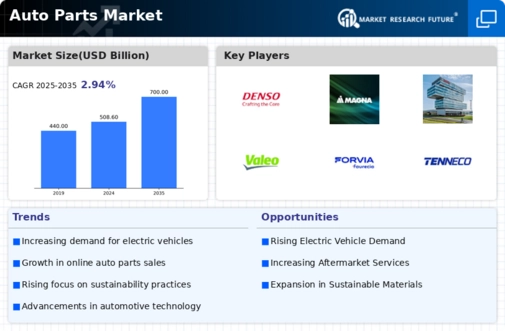Top Industry Leaders in the Auto Parts Market
*Disclaimer: List of key companies in no particular order
Top listed global companies in the Auto Parts industry are:
3M Co.
AISIN CORP.
Akebono Brake Industry Co. Ltd.
Autoliv Inc.
BorgWarner Inc.
Brembo Spa
General Motors Co.
HELLA GmbH and Co. KGaA
Hyundai Motor Co.
Lear Corp.
Magna International Inc.
Marelli Holdings Co. Ltd
Robert Bosch GmbH
Schaeffler AG
Stellantis NV
Tenneco Inc.
The Goodyear Tire and Rubber Co.
Toyota Motor Corp.
Valeo SA
ZF Friedrichshafen AG
Bridging the Gap by Exploring Top Leaders Competitive Landscape of the Auto Parts Market
The auto parts market is a vast and dynamic arena, constantly evolving with technological advancements, consumer preferences, and global economic shifts. This dynamic landscape fosters intense competition, with established giants and agile startups vying for market share. Understanding the key player strategies, market share analysis factors, and emerging trends is crucial for navigating this competitive terrain.
Key Player Strategies:
- OEMs (Original Equipment Manufacturers): Leading car manufacturers like Bosch, Denso, and Continental Automotive leverage their brand recognition, established distribution networks, and vertical integration to maintain market dominance. They invest heavily in R&D, focusing on lightweight materials, fuel efficiency, and autonomous driving technologies.
- Tier 1 Suppliers: These companies directly supply parts to OEMs, specializing in specific components like brakes, airbags, or engines. Delphi, Magna International, and ZF Friedrichshafen AG are prime examples. They prioritize cost optimization, operational efficiency, and strategic partnerships to secure long-term contracts.
- Tier 2 Suppliers: These players provide intermediate components and raw materials to Tier 1 suppliers. Companies like Lear Corporation and Cooper Tire & Rubber Co. focus on niche markets, customization, and cost-effective manufacturing to stand out.
- Aftermarket Players: This segment caters to car repairs and replacements, with giants like AutoZone, Advance Auto Parts, and O'Reilly Automotive leading the charge. They compete on price, accessibility, and service quality, building vast retail networks and online platforms.
Factors for Market Share Analysis:
- Product Portfolio: Offering a diverse range of high-quality parts across various segments (e.g., engine parts, electronics, interiors) is crucial.
- Innovation: Continuously developing new technologies and materials, like electric vehicle components or self-driving sensors, attracts market attention.
- Global Presence: Having a strong footprint across key regions like North America, Europe, and Asia Pacific maximizes reach and market share potential.
- Brand Reputation: Building trust and reliability through consistent quality and customer service is vital in a competitive market.
- Pricing Strategies: Balancing affordability with profitability through cost-effective manufacturing, strategic sourcing, and targeted pricing strategies is key.
New and Emerging Trends:
- Electric Vehicle (EV) Revolution: The rise of EVs is transforming the market, with demand for specialized parts like batteries, charging systems, and electric motors creating new opportunities for players who adapt and innovate.
- Connected Cars and Autonomous Driving: The integration of advanced technologies like sensors, software, and AI in vehicles is opening up new market segments for companies specializing in these areas.
- Sustainability and Green Materials: Growing environmental awareness is driving demand for eco-friendly materials and production processes, leading to innovations in lightweight materials and recycling technologies.
- E-commerce and Digitalization: Online platforms and mobile apps are reshaping the aftermarket landscape, with players focusing on convenient delivery, personalized recommendations, and digital marketing strategies.
Competitive Scenario:
The auto parts market is a complex chessboard with diverse players employing a range of strategies. OEMs and Tier 1 suppliers hold significant power due to their established relationships, but Tier 2 players and innovative startups can carve out niches through specialization and agility. The aftermarket remains competitive, with brick-and-mortar stores facing increasing pressure from online retailers. The rise of EVs and autonomous driving technologies further intensifies competition, as companies scramble to adapt and capture new market share. Success in this dynamic environment hinges on a clear understanding of customer needs, continuous innovation, strategic partnerships, and the ability to navigate the ever-evolving technological landscape.
Latest Company Updates:
3M Co.:
- Partnered with Ford to develop lightweight, heat-resistant materials for electric vehicle batteries. (Source: 3M News Release, January 17, 2024)
AISIN CORP.:
- Developed a new hybrid transmission for Toyota's next-generation hybrid vehicles. (Source: Nikkei Asian Review, January 12, 2024)
Akebono Brake Industry Co. Ltd.:
- Launched a new line of high-performance brakes specifically designed for electric vehicles. (Source: Akebono News Release, January 5, 2024)
BorgWarner Inc.:
- Received a major contract from a Korean automaker to supply electric vehicle charging systems. (Source: BorgWarner News Release, January 8, 2024)

